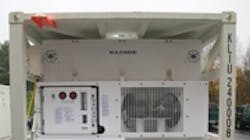Klinge transports polar ice samples from Antarctica
Three Klinge Corporation refrigerated containers made the final leg of a journey more than a year in the making.
These 40-foot refrigerated container systems conceptualized by US Antarctic Program support staff and designed by Klinge Corp were entrusted with transporting several million dollars worth of ice core samples collected from Antarctica.
Success of the mission was a testament to the employees from both companies and to numerous fail-safes in place for such valuable cargo. The Wall Street Journal published an article about the project and discussed the ice core’s path from Antarctica to the Denver CO lab, including Klinge’s role in making sure everything stayed safely frozen.
“While we knew this product was important, it was not until we met the scientists, National Ice Core Laboratory (NICL) employees, and project leaders from RPS that we understood how much had gone into obtaining these samples,” said Klinge’s project manager Allan Klinge. “From the intense core drilling process at the main arch, to flying the ice to McMurdo Station on the coast of Antarctica, to the coordination of a ship from halfway around the world, the importance of these ice cores was never in question.”
This made procurement of a reliable transport system back to Los Angeles CA and from there to NICL in Denver critical for the mission. Even more important, the ice cores were not permitted to rise above –20° C at any point during their 1.5-month travel from the Southern Hemisphere, across the equator, and through the southwestern United States—otherwise, some of the most vital research related to analysis of the gases contained in the cores would not be possible.
Key to this success has been Klinge’s line of dual refrigeration systems. The company also provides an integral, on-board generator set for emergency power.
“This can be extremely important in cases where the product will actually combust and explode if not kept at the correct temperature,” said Jason Flynn, Klinge’s sales manager. “You can imagine that a ship captain would not be too happy to have a product like this on board unless he knows the container has its own back-up refrigeration unit and generator set.”
The company expanded on built-in redundancies in the system by including not only two refrigeration units, but two back-up generator sets, as well. Each piece of equipment automatically switches to its back-up in the case of a loss of performance or power.
The Klinge design ensured a successful transfer of the ice back to NICL. The ultimate vote of confidence, of course, comes from the fact that the Klinge containers will return to the ice and complete this journey again in 2011.
Visit www.klingecorp.com for more information.
